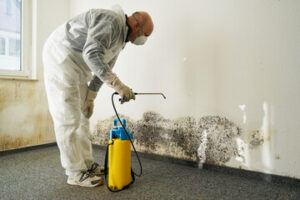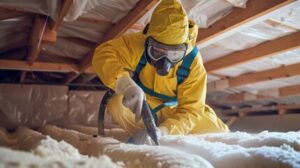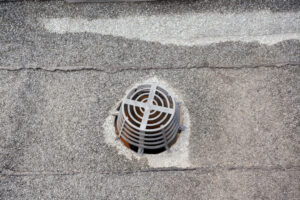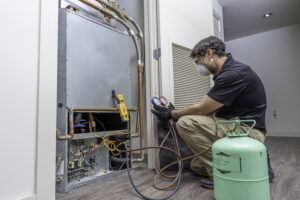Mold Remediation Provo involves removing and treating materials damaged by mold. Certain types of mold, such as toxic strains like Stachybotrys chartarum or “black mold,” pose serious health risks and require special handling.

The remediation process is a multi-step process that includes surface cleaning and the application of antimicrobial chemicals. Non-porous materials can usually be cleaned and salvaged, but porous materials must be disposed of.
A professional mold remediation process will begin with the containment of the affected area. The goal of this step is to isolate the moldy area from other parts of your home to protect occupants during the remediation process. This can be accomplished by creating a physical barrier with the use of plastic sheeting. The plastic will also need to cover shared airways like HVAC systems and any electrical outlets that are in the affected area. In addition, it is recommended that all windows and doors in the contaminated area be sealed with plastic as well.
In order to work safely within the containment area, a specialized personal protective equipment (PPE) suit should be used. PPE should include a mask with filter, disposable gloves, and a full pair of long pants and a shirt that covers the body to limit contact with mold spores. A respirator is often needed as well, especially in areas with high humidity levels or if there are other signs of airborne contaminants.
Mold spores can easily become airborne and can travel throughout your home through small gaps, cracks, and holes. Inhalation and ingestion of these spores can lead to various health effects including respiratory issues, allergic reactions, and infections. In some cases, exposure to certain molds can even be toxic.
As part of the containment process, it is important to find and locate the source of moisture that led to the mold growth. Whether the moisture is from a leak or condensation, it is essential to identify the source and fix it so that future mold growth can be avoided.
The next step of containment is to remove and dispose of any materials that are contaminated with mold. It is important to properly dispose of contaminated materials to prevent further contamination and to ensure that the fungus is completely removed from the environment.
During this stage, the contaminated materials will be cleaned, disinfected, and dehumidified to remove any lingering fungus. Porous materials such as drywall, carpeting, and insulation are typically removed and replaced. Non-porous materials such as cabinets, furniture and woodwork may be able to be cleaned and salvaged depending on the extent of the damage.
Removal
During this stage of the mold remediation process, any contaminated surfaces are cleaned to remove mold spores and other contaminants. This involves using a variety of cleaning agents and specialized microbial removal products. Once the area is clean, it’s important to dry the area thoroughly to prevent future growth. In some cases, porous materials such as drywall may need to be removed and replaced. This is often necessary in healthcare facilities and homes where individuals have respiratory conditions or weakened immune systems, as some types of mold such as Stachybotrys chartarum (known as black mold) can pose health risks for these groups.
If the affected surface is non-porous, a simple cleaning with a mild detergent can usually suffice. However, if the mold has penetrated the material, it will likely be necessary to use a utility knife to cut out the section and replace it. After this, it’s important to thoroughly wipe down the remaining surface to ensure that any spores have been removed.
Porous surfaces such as drywall are more difficult to clean and can require more extensive microbial remediation. This can include removing and replacing infected drywall, as well as disinfecting and dehumidifying the surrounding areas. In some cases, porous surfaces may need to be treated with fungicides.
It’s important to remember that, even if the visible mold has been eliminated and the moisture problem addressed, it is likely that the mold will return if the conditions that allowed it to grow are not addressed. For this reason, mold remediation should always be followed by a thorough inspection to ensure that all affected areas have been cleaned and the underlying issues have been resolved.
Cleaning
Mold is not only unsightly, but it can also eat through surfaces like wood and drywall. Depending on the type of mold, it can also produce toxic spores that can affect human health. For this reason, it’s important to remove any visible mold growth as soon as possible.
The first step in the cleanup process is to examine the affected area and collect air samples. This can help experts determine the type of mold present and how widespread the infestation is. It can also help them trace the source of the moisture that caused the mold to grow.
Once the examination and testing is complete, the professionals can start cleaning. This involves scrubbing and using specific chemicals to eliminate both the visible mold and hidden spores. Non-porous surfaces can typically be cleaned with simple cleaning products, while more porous materials like drywall and carpet may need to be removed and replaced.
During this stage, it’s important to wear protective gloves and goggles, as well as use a respirator if the situation warrants it. This is especially important when dealing with black mold, which can produce toxins that are dangerous to human health. Black mold is typically found in areas with high moisture levels, such as bathrooms and basements. It can also be found in wallpaper and fabric.
To kill mold spores, a combination of hydrogen peroxide and baking soda can be used. Mix equal parts of the two ingredients together until they form a paste, and then apply it to the mold growth. Wait for at least 30 minutes before scrubbing the surface with a scrub brush and then rinsing it thoroughly. It’s also important to make sure the area is completely dry, which can be accomplished by using fans and a dehumidifier.
The next stage is to seal off the affected area with plastic sheets, and then sealing and securing doors, vents, and windows. It’s also a good idea to wear disposable clothing and/or coveralls during this process, and to seal any contaminated materials (like scrub brushes, rags, or sponges) in plastic bags before disposing of them.
Remediation
Mold spores can cause many health problems, especially in people with asthma or immune system issues. They can also cause damage to the structure of a home or office and create musty or stale odors. Mold remediation is the process of reducing and treating the conditions that cause mold growth. It includes abatement, cleaning, and prevention. This step is essential in restoring your property to a healthy, livable condition.
The goal of mold remediation is to clean, disinfect, and dry all areas affected by mold. This includes removing porous materials such as drywall and insulation, and sanitizing non-porous surfaces such as flooring and furniture. Remediation also includes air filtration and temperature and humidity control. It should be noted that mold spores will continue to grow and thrive in environments where the moisture problem remains unaddressed, so preventative measures are essential after the remediation process is complete.
Remediation Level II is appropriate for mid-sized isolated areas and can be performed by regular building staff who have received training on clean-up methods, potential hazards, and safety measures. However, the expanded procedures and increased safety requirements of Level III remediation make it necessary to hire a professional to carry out this work.
Level IV remediation is reserved for the most extensive contamination. It requires additional training and use of protective equipment to ensure the health and safety of the remediation team as well as those in the affected area. This level of remediation typically involves removing porous, mold-infested materials and installing new ones, such as drywall. It may also include removing and replacing HVAC components and sealing all joints and seams in the affected areas to prevent mold spores from spreading further.
When all steps in the remediation process are complete, a visual inspection should be performed to ensure that there is no visible or obnoxious mold and that there is no longer a musty or stale odor present. In addition, an air test should be conducted to determine if the mold levels have been reduced to a safe level for occupancy. If the results indicate that the occupants are still experiencing respiratory irritation or physical symptoms, further evaluation and testing should be undertaken.



